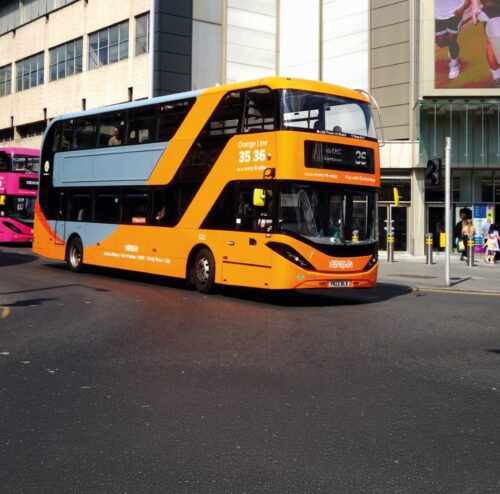
orange-liveried biogas-powered Alexander Dennis Enviro400City CBG YN22 BLX, branded for routes 35 and 36. RAY WARD
Jonathan Welch takes a short and timely look back at the history of Nottingham City Transport, which this year played host to the annual ALBUM conference
As the host of this year’s ALBUM (Association of Local Bus Company Managers) conference, Nottingham City Transport (NCT) has been in the spotlight over the last week, as delegates from independent operators, those outwith the big groups, across the country descended on the city for the three day event. On the final day, delegates were able to participate in a visit to the company’s Trent Bridge depot for a look behind the scenes.
Well known throughout the industry for its high standards and numerous awards, the company’s history dates back to the 1870s. Today, NCT is the second-largest municipal operator in the UK, behind Lothian Buses, but it was almost 150 years ago on Thursday 17 September 1878 when the company’s forerunner the Nottingham and District Tramways Company operated its first services with horse-drawn trams. It operated two routes, both starting at the city’s St Peter’s church. One ran to Trent Bridge and one to London Road; the routes connected the city’s two main railway stations of the time.
11 August the following year saw the start of another service between Nottingham’s central Market Place and St John’s church in Carrington, followed by a further route to the city’s Church Street gas works. The gradient going up Derby Road is said to have been difficult, with an additional pair of horses needed to pull the tram car up. Further tram cars were purchased in 1881, taking the total fleet to 22, including three double-deck cars, whilst a steam tram engine introduced in 1882 reduced the length of journeys by 10 minutes compared to a horse. Operational modernisation came in 1895 when the company fitted electric lights in its offices for the first time and purchased its first telephones, and by the subsequent year the company had grown its fleet to 38 tram cars, 16 omnibuses and 290 horses. That’s 54 vehicles with a combined 290 horsepower!

a Nottingham depot reveals buses and trams undergoing maintenance, including one bus body supported on barrels. NOTTINGHAM CITY TRANSPORT
Municipal take-over
On 16 October 1897, Nottingham Council took over the Nottingham Tramway Company, and shortly after a proposal was made in 1898 to electrify the system, with eight routes proposed; the place names will still be familiar to NCT’s passengers today. The plan was approved in 1899 (a year in which services were also briefly suspended due to an outbreak of illness in the horses), and although the first nine electric trams arrived for assembly that year, it would be mid-November 1900 before the first one was tested.
[…]Are you enjoying this feature? Why not subscribe to continue reading?
Subscribe for 6 issues/weeks from only £6Or login if you are already a subscriber
By subscribing you will benefit from:
• Operator & Supplier Profiles
• Face-to-Face Interviews
• Lastest News
• Test Drives and Reviews
• Legal Updates
• Route Focus
• Industry Insider Opinions
• Passenger Perspective
• Vehicle Launches
• and much more!


